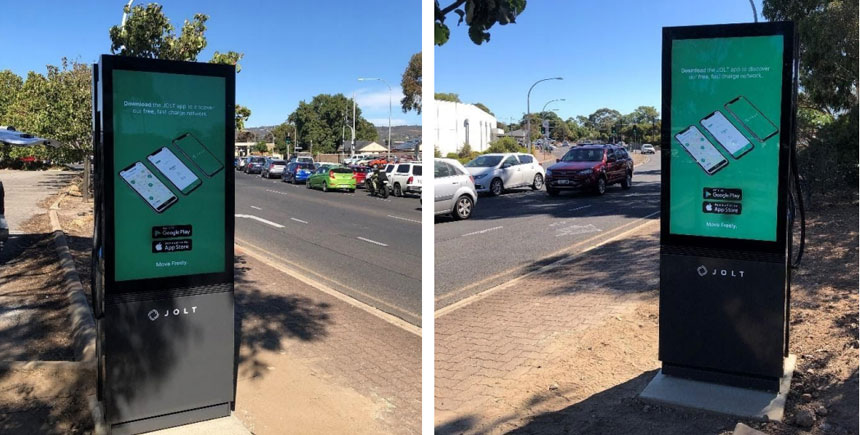Advertising Revenue Funded EV Charging Trial

The project deployed 21 JOLT EV charging and advertising panels in car parks and public spaces in multiple Adelaide municipalities. The project will test the commercial viability of generating revenue through advertising sales to cover the cost of both the EV charging infrastructure and the provision of charging for EV drivers. Chargers will provide free charging for approximately 15 minutes, providing drivers with approximately 45km of range. Users can pay to use the JOLT chargers for longer than this period.
Start and end dates: Start December 2020, ongoing
Lead organisation: Jolt Charge
Location: Adelaide, South Australia
Project budget, funding sources, components or breakdown of cost: $1.97m total project cost, $0.98m funded by ARENA
Contact person: Doug McNamee, Partnerships Director, Jolt
Link to project website: Metro Advertising Revenue Funded Electric Vehicle Charging Trial
Included technologies
- Battery recharging infrastructure
Project stages
- Deployment encouragement
Included locations
- Urban high traffic / high speed roads
- Urban low traffic / low speed roads
- Urban non-road
Benefits directly sought by the project
- Reduce environmental impact
- Increase public support to assist deployment and adoption
- Commercial return - product / service development
Project scale
- 21 EV fast charging units embedded in roadside advertising panels will be installed across Adelaide in car parks, streets and public spaces.
- The network will be rolled out across several local government areas consisting of Campbelltown City Council, Charles Sturt Council, Marion Council and Port Adelaide Enfield Council.
Further details on included technologies
All of the 21 units will be powered by 100 per cent renewable energy. The 7kWh of free charging is provided in approx. 15 minutes.
The project tests a business model that seeks to decouple the commercial returns from installing EV charging stations from solely the value of the electricity supplied by supplementing this with advertising revenue. Were this business model to succeed, it could assist realisation of a larger charging network in inner cities and major networks across Australia in advance of the expected increase in EV sales.
The project is also expected to provide general lessons learned around the practicality of deploying advertising supported EV chargers in urban environments.
Lessons learned that inform future technology deployments
- Considerations used in identifying potential sites have included:
- Safe access, particularly for vehicles to be recharged
- Highly visible locations with high passing traffic and / or pedestrians
- Suitable access to power, particularly 63A 3-phase power
- Current and expected future demand for EV charging.
- Road safety requirements (by government) such as curb setbacks, sightlines for side streets and clearances for pedestrians all impact where sites may be feasible and the design of these sites. Early identification of these requirements is recommended, along with engagement with relevant stakeholders.
- Some local governments have sought to limit the types of advertising that may be displayed on boards located on public land.
Links to project lessons learned and / or benefit assessment reports
First interim lessons learned report
Links to any other supporting project reports
Last updated: May 2021.
